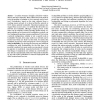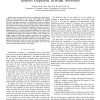50 search results - page 8 / 10 » Designing Sparse Wireless Multi-Hop Networks |
INFOCOM
2010
IEEE
13 years 8 months ago
2010
IEEE
— Location awareness is highly critical for wireless ad-hoc and sensor networks. Many efforts have been made to solve the problem of whether or not a network can be localized. Ne...
ICC
2007
IEEE
14 years 4 months ago
2007
IEEE
—Uplink-Downlink imbalance is a characteristic of all wireless networks which greatly impacts system performance, and must be accounted for in system design and simulation. Howev...
LCN
2006
IEEE
14 years 3 months ago
2006
IEEE
Multi-hop relaying is an important concept in future generation wireless networks. It can address the inherent problems of limited capacity and coverage in cellular networks. Howe...
GLOBECOM
2010
IEEE
13 years 7 months ago
2010
IEEE
This paper considers a large-scale wireless sensor network where sensor readings are occasionally collected by a mobile sink, and sensor nodes are responsible for temporarily stori...
INFOCOM
2008
IEEE
14 years 4 months ago
2008
IEEE
Abstract—In road networks, sensors are deployed sparsely (hundreds of meters apart) to save costs. This makes the existing localization solutions based on the ranging be ineffect...


